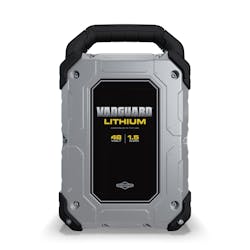Technology Partnerships Enable Optimized Pairing of Batteries and Fluid Power Systems
Engine manufacturer Briggs & Stratton expanded into the electrification space in 2019 with the introduction of its first Vanguard Commercial Lithium Ion Battery pack. Since then, the company has introduced new battery pack sizes as well as formed various industry partnerships.
Included in these partnerships are those with hydraulic and pneumatic component manufacturers and system integrators. Known as Battery Technology Partners, Vanguard works with these companies to supply its battery technology while also providing its expertise in developing power systems for various machine applications.
READ MORE about Vanguard's most recently formed Battery Technology Partnerships:
Briggs & Stratton forms partnership with Canimex Group
Briggs & Stratton partners with Hydraulic Controls Inc.
Briggs & Stratton forms partnership with Hydra-Power Systems
The implementation of electric-powered systems has a direct impact on the operation of fluid power components, making these partnerships vital to ensuring all machine systems perform as desired.
Power & Motion spoke with Brett Engelland, Director of Sales for Electrification, and Nick Moore, Director of Product Management for Electrification at Vanguard, about how the company works with its Battery Technology Partners* and the benefits of doing so.
Power & Motion (P&M): Vanguard has formed several Battery Technology Partnerships recently with companies specializing in fluid power engineering and system integration capabilities – what is driving the increase with these types of industry partners?
Brett Engelland and Nick Moore (BE & NM): Many OEMs want to start their electrification journey but don’t necessarily have the resources in-house to execute an electrification project. These OEMs know the future is moving toward electrification and that they need partners to help them integrate a total solution — battery, motors, controllers, wiring, etc. — into their application. This Is where a Vanguard Technology Partner shines.
Like electrified solutions, fluid power systems are complex, so the engineering resources a Technology Partner is able to offer an OEM are essential to navigating the entire process and finding the best solution for that particular application.
READ MORE: How to Safely Work with High-Voltage Systems
P&M: What is the value, to both Vanguard and the industry, in partnering with those who specialize in developing and integrating fluid power systems?
BE & NM: Our Technology Partners in the fluid power engineering space have an extensive understanding of the OEM’s requirements and challenges. Often, the Technology Partner has been working with the OEM for years on hydraulic applications. An OEM’s electrification project will go much more smoothly when working with a partner who knows and understands what they need. Vanguard and the larger industry share the goal of bringing more electrification options to core applications, and these partners help accelerate that transition.
P&M: How does the company see battery technology and fluid power systems working together, and what benefits can be achieved?
BE & NM: Some of the benefits we’ve realized through our Battery Technology Partners include the opportunity to improve efficiency and emissions performance for OEMs and to help them get ahead of changes in the legislative landscape.
Emissions control, specifically, is an area of importance since we are seeing an increasing demand for zero-emission equipment designed for indoor construction work. While there are solutions that can eliminate the fluid systems altogether, in many cases, the best operating systems will still require functionality that only fluid power can deliver.
P&M: Does the company simply supply its batteries to its Battery Technology Partners or does it also provide any technical advice?
BE & NM: With 35 years in commercial power and 115+ years in power application, Vanguard has the resources to do more than just provide battery packs to our partners. We have the power application and engineering expertise to work side-by-side with our Technology Partners and their OEMs to ensure the end product is successful. We use the term Technology Partner, not distributor, very purposefully here. We work closely to train their teams, answer questions and be an available technical resource to ensure the best solutions are being designed.
Briggs & Stratton's Vanguard brand will exhibit its various battery pack technologies, including its most recently introduced swappable battery pack at CONEXPO/IFPE 2023. Visit our IFPE channel for more on this and other technologies at this year's largest construction and fluid power industry event.
P&M: From Vanguard’s perspective/experience, what special considerations need to be taken into account when bringing together batteries and fluid power systems?
BE & NM: In most cases, there are many different ways to solve a problem that allows a machine to do the work required of it. There is a wide range of fluid power system components that can be paired with electrical systems.
Our goal will always be to help our customers and their stakeholders to find the solution that makes the most sense for their needs — whether that’s fully electric or a hybrid solution. In many cases, properly combining battery and fluid technologies can yield significant improvements to the overall functionality of a machine.
P&M: How does the company see electrification continuing to progress in the coming years, and how might it continue impacting fluid power and other vehicle systems?
BE & NM: We see the shift toward electrification as another solution we can offer our stakeholders rather than a trend. The need to reduce emissions and operate efficiently while still delivering on an expected full day's work will continue to drive this technology forward.
Vanguard and our Technology Partners are an ideal way for OEMs in the fluid power space to provide electrification solutions to their customers while they navigate the fast-changing industry landscape.
*Editor's Note: Vanguard provided the following disclaimer regarding the use of the term 'partner': Vanguard® has not formed any legal partnerships with Battery Technology Partners. The word partner or partnership signifies the collaboration between Vanguard and the respective company and their agreement to work together to help customers electrify their equipment using knowledge and resources from both companies.
About the Author
Sara Jensen
Executive Editor, Power & Motion
Sara Jensen is executive editor of Power & Motion, directing expanded coverage into the modern fluid power space, as well as mechatronic and smart technologies. She has over 15 years of publishing experience. Prior to Power & Motion she spent 11 years with a trade publication for engineers of heavy-duty equipment, the last 3 of which were as the editor and brand lead. Over the course of her time in the B2B industry, Sara has gained an extensive knowledge of various heavy-duty equipment industries — including construction, agriculture, mining and on-road trucks —along with the systems and market trends which impact them such as fluid power and electronic motion control technologies.
You can follow Sara and Power & Motion via the following social media handles:
X (formerly Twitter): @TechnlgyEditor and @PowerMotionTech
LinkedIn: @SaraJensen and @Power&Motion
Facebook: @PowerMotionTech

Leaders relevant to this article:


